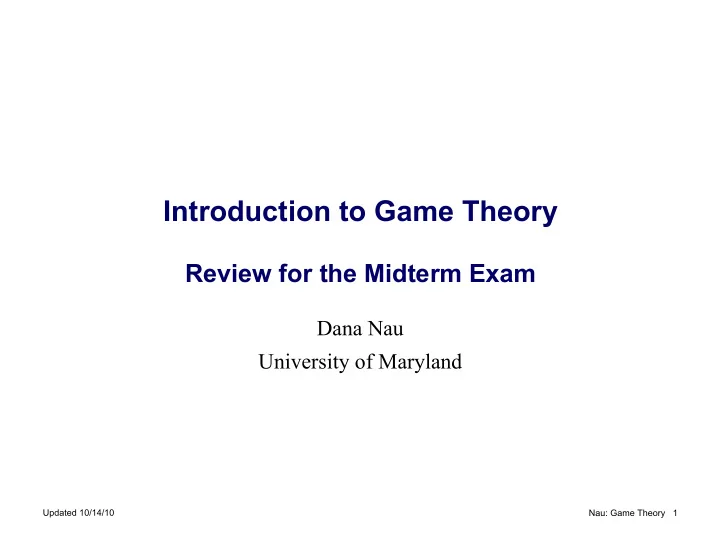

Introduction to Game Theory Review for the Midterm Exam Dana Nau University of Maryland Updated 10/14/10 Nau: Game Theory 1
Part 1 Basic concepts: normal form, utilities/payoffs, pure strategies, mixed strategies How utilities relate to rational preferences (not in the book) Some classifications of games based on their payoffs Zero-sum • Roshambo, Matching Pennies Non-zero-sum • Chocolate Dilemma, Prisoner’s Dilemma, Battle of the Sexes, Which Side of the Road? Common-payoff • Which Side of the Road? Symmetric • all of the above except Battle of the Sexes Updated 10/14/10 Nau: Game Theory 2
Part 2 I’ve discussed several solution concepts, and ways of finding them: Pareto optimality • Prisoner’s Dilemma, Which Side of the Road best responses and Nash equilibria • Battle of the Sexes, Matching Pennies • finding Nash equilibria real-world examples • soccer penalty kicks • road networks (Braess’s Paradox) Updated 10/14/10 Nau: Game Theory 3
Part 3 maximin and minimax strategies, and the Minimax Theorem Matching Pennies, Two-Finger Morra dominant strategies Prisoner’s Dilemma, Which Side of the Road, Matching Pennies Elimination of dominated strategies rationalizability the p -Beauty Contest correlated equilibrium Battle of the Sexes trembling-hand perfect equilibria epsilon-Nash equilibria evolutionarily stable strategies Hawk-Dove game Updated 10/14/10 Nau: Game Theory 4
Part 4a Extensive-form games relation to normal-form games Nash equilibria subgame-perfect equilibria backward induction • The Centipede Game backward induction in constant-sum games Updated 10/14/10 Nau: Game Theory 5
Part 4b If a game is two-player zero-sum, maximin and minimax are the same If the game also is perfect-information, only need to look at pure strategies If the game also is sequential, deterministic, and finite minimax game-tree search - minimax values, alpha-beta pruning In sufficiently complicated games, perfection is unattainable must approximate: limited search depth, static evaluation function In games that are even more complicated, further approximation is needed Monte Carlo roll-outs Updated 10/14/10 Nau: Game Theory 6
Part 4c In most game trees Increasing the search depth usually improves the decision-making In pathological game trees Increasing the search depth usually degrades the decision-making Pathology is more likely when The branching factor is high The number of possible payoffs is small Local similarity is low Even in ordinary non-pathological game trees, local pathologies can occur Some research has been done on algorithms to detect and overcome local pathologies, but it’s rather limited Updated 10/14/10 Nau: Game Theory 7
Recommend
More recommend